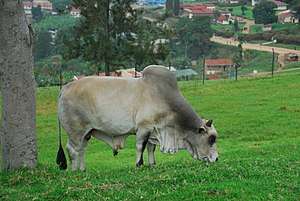Sohr Damb
Sohr Damb ('Red Mound') is an archaeological site, located near Nal, in central Balochistan, Pakistan that predates the Indus Valley civilization. It has also been known as 'Nal', and gave its name to the prehistoric 'Nal culture'.
The site extends over 4 hectares; the mound (mostly geologically formed) is 13 m high. The cultural stratum is less than 2 m deep. The excavations reveal four periods of occupation dating from 3800 to 2200 BC. They could be further divided into several sub-periods.
Excavations
The locality was first discovered in 1903. In the following years, various minor excavations took place, including by Sir Aurel Stein. Since 2001, the site has been systematically excavated by the German Archaeological Institute and the Department of Archeology and Museums, Government of Pakistan.
Periodisation
The oldest period (Period I) belongs to the cultural complex called Togau. Numerous burials were found. Some of them were found located in small chambers, and they contained up to 16 skeletons. The grave goods included ceramics, pearls, as well as semi-precious stones and shells.
During Period II, we see the appearance of the Nal culture complex. The dead were now buried in individual graves. There are only a few vessels offered as grave goods. The excavated mud-brick houses are usually small. There was a lot of utility ceramics, but also some brightly painted ceramics typical of the Nal culture. There were also millstones, bone implements, and pearls.
Period III is closely related to the other cultures of the area, such as Mehrgarh, and Mundigak in Afghanistan. The mud-brick architecture has now become larger; copper makes its appearance, while the ceramics become simpler. Copper and ceramics were probably processed/produced on site.
The Period IV layers are badly eroded. Overall, this period belongs to the Kulli culture, as well as the Indus culture.
Agriculture

Domesticated cattle bones are plentiful in the settlement, and bull figurines are also found. The bones were identified as coming from humped or Zebu cattle.[1]
Sheep and goats were also kept. The inhabitants also had dogs. Wild mammals account for only 5% of the bone remains.
The crops like wheat, and hulled and naked barley were used from the earliest period. Later, the crops indigenous to the Indian subcontinent, like sesame, and millet became more popular.
The sesame sample from Period III is the oldest, stratified record from this crop until now.
Both wild and cultivated fruits were exploited. Fig, jujube, dwarf palm and grape vine were quite popular.[2]
Sohr Damb in context
Sohr Damb/Nal is stratigraphically earlier than the Kulli culture phase. Also, at Surab, Nal occupations are later than the Kili Gul Mohammad phase.
In the past, the Nal cemetery was understood as belonging to the Kulli Culture. But more recently, Nal is rather understood as belonging to its own pottery tradition, linked more to Baluchistan.[3]
Sohr Damb ceramics, wheel-turned, and with polychrome decoration, shows some parallels with Mundigak period III1-6.[4]
There's some controversy about the absolute chronological framework of the transition from Period II to III at Nal. This transition has a bearing on the chronology of both Shahr-e Sokhta, and of the Indus civilization. The transition can be dated either to the mid-3rd millennium, or to the late 3rd millennium BC.[5]
Early Nal has an affinity with Amri, Sindh. Their pottery is quite similar.
Kulli-Mehi culture is in some ways a continuation of Nal.
See also
Notes
- Benecke N, Neef R. 2005. Faunal and plant remains from Sohr Damb/Nal: a prehistoric site (c. 3500–2000 BC) in central Balochistan (Pakistan). In: Franke-Vogt U, Weishaar J, editors. South Asian Archaeology 2003. Aachen: Linden Soft. p 81–91
- Benecke N, Neef R. 2005. Faunal and plant remains from Sohr Damb/Nal: a prehistoric site (c. 3500–2000 BC) in central Balochistan (Pakistan). In: Franke-Vogt U, Weishaar J, editors. South Asian Archaeology 2003. Aachen: Linden Soft. p 81–91
- Paul Yule (2013), Silver Grave Goods from the Sohr Damb near Nal, Pakistan. Universität Heidelberg
- Paul Yule (2013), Silver Grave Goods from the Sohr Damb near Nal, Pakistan. Universität Heidelberg
- Jochen Görsdorf, Ute Franke-Vogt, IMPLICATION OF RADIOCARBON DATES FROM SOHR DAMB/NAL, BALOCHISTAN. RADIOCARBON, Vol 49, Nr 2, 2007, p 703-712
Literature
- Paul Yule (2013), Silver Grave Goods from the Sohr Damb near Nal, Pakistan. Universität Heidelberg
- Benecke N, Neef R. 2005. Faunal and plant remains from Sohr Damb/Nal: a prehistoric site (c. 3500–2000 BC) in central Balochistan (Pakistan). In: Franke-Vogt U, Weishaar J, editors. South Asian Archaeology 2003. Aachen: Linden Soft. p 81–91.
- Jochen Görsdorf, Ute Franke-Vogt, IMPLICATION OF RADIOCARBON DATES FROM SOHR DAMB/NAL, BALOCHISTAN. RADIOCARBON, Vol 49, Nr 2, 2007, p 703-712
- Hargreaves H. 1929. Excavations in Baluchistan 1925. Sampur Mound, Mastung and Sohr Damb, Nal. New Delhi: Memoirs of the Archaeological Survey of India 35.
- Salvatori S, Tosi M. 2005. Shahr-e Sokhta revised sequence. In: Jarrige C, Lecomte O, editors. South Asian Archaeology 2001. Paris: ADPF Éditions Recherche sur les Civilisations. p 281–91.
External links
- Archaeology of Ancient Balochistan - Slide show (including examples of 'Nal ware') - harappa.com